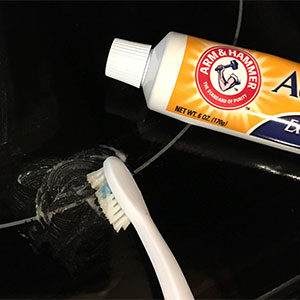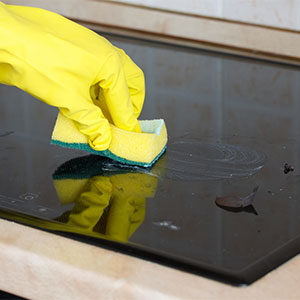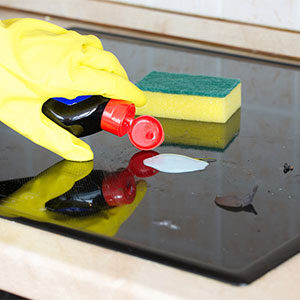How to Remove Scratches from a Glass Stovetop

Glass Stovetop
A big shoutout for easy cleanup, safety features, and the sleek profile of glass stovetops. But everything seems worthless when you find some light or deep scratches on your stovetop. However, if you know how to remove scratches from a glass stovetop, it’s nothing tough to deal with it.
And, luckily, we are here to share some useful tips and tricks for removing scratches from glass stovetops. So, you will have a crystal clear idea of this topic at the end of the article, no doubt. There’s an FAQ section as well that you’ll find helpful.
Now, let’s start without having more chitchats!
7 Methods of Removing Scratches from a Glass Stovetop
Here, we have laid out 7 effective ways you can follow when it comes to removing scratches from a glass stovetop. Let’s check them out!
Method 1: Using Baking Soda
We are starting with the simplest way to remove scratches from a glass stovetop. If you can properly mix, it will not seem abrasive or dry.
Things You’ll Need
- Baking soda
- Water
- Soft cloth
Step-Step Process
- Take a small container in the first place. Then, add water to baking soda and combine it well. You will want a wet, loose paste.
- Use your fingers to apply that paste to your stovetop. Make sure the stovetop is cool.
- Now, gently scrape away the scratches and polish the stovetop using a soft cloth.
- Finally, dampen a clean cloth and remove the paste.
That’s all, you are done with method one.
 Method 2: Using Toothpaste
Method 2: Using Toothpaste
Does it sound a bit strange that you are using toothpaste in order to remove scratches from your stovetop?
Well, it may sound strange, toothpaste comes with peroxide and baking soda that are effective ingredients for cleaning purposes.
Things You’ll Need
- Two pieces of soft cloth
- Whitening toothpaste
Step-Step Process
- First of all, take one piece of soft clothes. Then, squeeze a gentle amount of whitening toothpaste onto it.
- Mark the damaged area and then apply the paste here. Rub it maintaining a circular motion for at least 1 minute.
- Dampen the other piece of cloth and wipe the paste gently.
- Next, take the dry cloth and wipe your stovetop down for cleaning up any remaining liquid.
- If you think you don’t like the outcome, you can repeat the steps.
This was all removing scratches with toothpaste. It’s a great idea for getting rid of stubborn food stains.
Method 3: Metal Polish Method
Here’s another effective way you can follow for removing scratches from a glass stovetop. Metal cleaners are also known as polishes, they work great on glass.
Things You’ll Need
- One glass- metal polish
- Wool pad
- A soft cloth
Step-Step Process
- Take the cloth and the pad firstly and pour a gentle amount of the cleaner on them.
- Move the pad maintaining a circular motion and slowly scrape away the scratches.
- Once done, dampen the cloth and use it to wipe away the cleaner.
- To get the result, you can dry the stovetop using a separate soft cloth.
There you have it! See, the worst of the scratches are no more visible there.
 Method 4: Using Nail Polish
Method 4: Using Nail Polish
Does it sound even more strange to use nail polish for this cleaning job? Trust me, nail polish works great when it comes to cover as well as hide the large areas of damages.
Both the clear polish and glass polish are great for eliminating scratches.
Things You’ll Need
- Clear nail polish
- Glass nail polish
- Buffing pad (light)
Step-Step Process
- First and foremost, mark the scratched and damaged areas on your stovetop. Then, cover those areas with clear nail polish. Simply do the job using the brush you get with the nail polish.
- If there’s any excess polish on your stove, make sure you wipe it away before it dries. You will not like it to stick to the stove actually.
- Wait for around 30 minutes and let the remaining polish dry.
- Grab a non-abrasive pad and rub the areas with nail polish. Do this job for a minimum of 30 seconds.
- Once done, take a buffing pad and pour a gentle amount of the glass polish on it, then, carefully touch up the treated areas.
This is how you can have a clear and shiny stovetop.
Method 5: Using a Glass Repair Kit
It’s one of the methods available to remove scratches from a glass stovetop. If you use a basic glass repair kit, it means you choose a option for the finish your stovetop will get.
Things You’ll Need
- Multiple wool pads or soft cloths
- A glass repair kit
Step-Step Process
Hence, the instructions to make this job happen will depend on the type of kit you are going to use. So, it’s better to follow the instructions that come with the kit you bought. However, you need to take extra caution to seal the chances of happening further damages.
 Method 6: Using Ammonia
Method 6: Using Ammonia
You may be familiar with using ammonia to clean household items. Ammonia contains a strong chemical. And, guess what?
That strong chemical will become a villain for the scratches but a blessing for your stovetop.
Things You’ll Need
- Ammonia
- A soft cloth
- Water
Step-Step Process
- First of all, take 20 ml of ammonia and add it to 473 ml of water. Once you’re done with mixing the ammonia solution, move on to the next step.
- Take the soft cloth and damp it with the solution. Gently scrape away the scratches with the cloth and do it in a circular motion.
- If it’s necessary, repeat the process to completely remove the scratches.
- Before you cook again, let the solution dry first.
That’s all you have to do, and it’s an effective way to remove the scratches.
Method 7: Ceramic Cleaning Cream Method
It works almost the same as a metal polish and you will find it in similar stores. Although it doesn’t work well to remove deeper scratches, it’s good for removing minor scratches.
Things You’ll Need
- Ceramic cleaning cream
- Water
- Multiple soft clothes
Step-Step Process
- Take a gentle amount of ceramic cleaning cream onto the soft cloth and scrape away the scratches with it. Maintain a circular motion here and accumulate around 30 seconds for each area.
- Take a separate dry cloth to wipe away the polish.
- And, you need to wipe those areas again. But this time, use a wet piece of fabric to do the job.
How to Get Rid of Discoloration
Well, it’s normal that there will be acids or oils on your stovetop when you cook food, and they are the reasons why the surface of your stovetop gets light or dark stains. However, it’s not so tough to get rid of the discoloration if you use vinegar.
Vinegar is widely used for day-to-day household maintenance because it’s an all-natural cleaner. If your glass stovetop has chalky or simply white discoloration (that generally happens because of the minerals in the water), vinegar can rub it off.
To get the job done, you need to spray vinegar to the entire glass and then wait for a few seconds to let it sit. After that, use a soft, white cloth to wipe it down. You’re done when the glass looks completely clean.
And, in case, you don’t find it satisfactory, you can apply a dash of baking soda over the areas of discoloration. Then, take a bowl filled with warm water and dampen a hand towel with that water. Put the cloth on your stovetop and wait for 15 minutes. Rub the glass using that towel. Rinse the towel frequently and rub the glass with it. Finally, take vinegar to a soft cloth and buff the glass with that cloth.
You will get a sparkling glass stovetop by following these properly.
Tips to Prevent Your Glass Stovetop From Scratching
Although glass stove tops are very attractive, they are vulnerable to scratches. Once there are scratches, your stovetop may not look like the very new one. Therefore, the option is to seal the chances of getting scratches at all.
You can prevent them altogether, there are ways. Here you go:
- Keep the bottom of the pans and pots you use clean. Make sure you scrub the bottoms regularly because any burnt-on food residue may damage the stove.
- Pick a pan up gently instead of moving it backward and forward over the burner.
- Only choose the pans and pots that come with smooth bottoms to use on your glass stove.
- You should clean spills right after they feel cool enough so that you can wipe them away. Sugary spills are not that famous for bringing pitting.
- Try to keep a distance between the glass cooktop and the aluminum foil you use. It’s because aluminum foil may leave dark/grey marks that people can easily notice on white cooktops.
- Even if you are not using it now, keep the surface clean.
- Pans that have stainless steel bottoms are the for using, they don’t get scratched so easily.
- While your stovetop is not in use, you can protect it using a glass stove top cover.
- Try not to use any abrasive cleaner or any harsh, metal scrubber to clean your glass stovetop.
- When you cook, make sure you don’t put any stirring utensil on the cooktop when it’s warm.
- You should read the manufacturer’s instructions and apply the knowledge while handling your glass stovetop.
10 Best Stovetop Griddle For Delicious And Crispy Homemade Food
FAQs of Glass Stovetop
Conclusion
Voila! You now know everything how to remove scratches from a glass stovetop. It’s pretty easy to do the job when you can follow the instructions properly.
Take the cleaning and maintenance of your glass stovetop seriously if you want it to last long. Regular maintenance will not kill a lot of time, you just should not put today’s work for the next weekend!
So, good luck!



